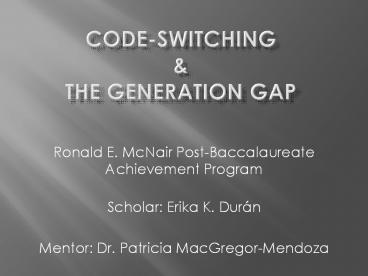Code-switching - PowerPoint PPT Presentation
Title:
Code-switching
Description:
... and information theory.* *According to Peter Auer s book Code-Switching in Conversation People of lower ... Seeing if the generation gap effects their way of ... – PowerPoint PPT presentation
Number of Views:227
Avg rating:3.0/5.0
Title: Code-switching
1
Code-switchingthe Generation Gap
- Ronald E. McNair Post-Baccalaureate Achievement
Program - Scholar Erika K. Durán
- Mentor Dr. Patricia MacGregor-Mendoza
2
Two countries Three cities
3
What is Code-Switching?
- The transitioning back and forth between two
languages for convenience, emphasis, humor, etc.
4
...Continued
- Code-Switching is not a linguistic
phenomenon,but rather a psychological one
(Haugen 1954 368). - Haugen also refers to the code-switching which
occurs when a bilingual introduces a completely
unassimilated word from another language into his
speech(1956 40).
5
History of Code-Switching
- Started in the early 1950s.
- It was not Haugen who used the term first, rather
Hans Vogt in an article in 1954.
6
Continued
- In 1952 Roman Jakobson established the
- terms success by drawing parallels between
- language switching, co-existent phonological
- systems in borrowing, and information
- theory.
7
Different types of Code-Switching
- Pidgin-Creoles
- Diglossia
- Borrowing
- Calques
8
Pidgin-Creoles
- People of lower status learn some words of
- those in power their children expand these
- words into a language.
9
Diglossia
- A functional separation of language one
- language is used in certain places (e.g.
- church) and another is used in other places
- (e.g. government offices).
10
Borrowing
- A terms from another language and changing the
pronunciation. (e.g. Cornfles, Peksi, Taco,
Tortilla)
11
Calques
- Translating phrases in one language whose
components are translated into another language. - (e.g. blue blood sangre azul.)
12
How languages weave together
English Spanish Spanglish
Hybrid Anglicization Population Población Populación
Literal Translation Doctors office Consultorios Oficina del doctor
Literal (Wrong meaning) Embarrassed Vergüenza Embarazada
Same Semantics Emergency Urgencia Emergencia
Borrowing Pin Alfiler Pin
Phonological Similarities Library Biblioteca Librería
13
Research
- I conducted a quantitative study on how people of
different ages and genders weave togetherSpanish
and English.
14
Who?
- The research consisted of5 females and 5 males
from each of two age groups - (20 30 years old 70 and above).
15
Why these ages?
- The reasoning behind why these age groups were
chosen was to compare college age students
vs.their grandparents age. - Seeing if the generation gap effects their way of
speaking.
16
What?
Each informant was asked to sign a consent form
allowing me to digitally record them. They were
also informed that they will remain anonymous and
no one but myself will listen to the recordings.
17
Continued
Each informant provided a brief history on their
English/Spanish language acquisition,
proficiency, and use.
18
(No Transcript)
19
ContinuedSpanish Abilities
20
ContinuedEnglish Abilities
21
Continued
- The informants were asked to orally narrate
- Frog Where are you?, by Mercer Meyer,
- a book without words. They were asked to recited
the story switching between Spanish and English.
22
Partial results
23
Continued
- They were also asked to retell the story of La
Llorona or another fairy tale that they
remembered, also switching between Spanish and
English.
24
Partial results
25
Goals
- Seek patterns of their linguistic behaviors,
exploring different informants use of
code-switching, borrowing, and calques. - Examine the patterns to see if there are any
similarities or differences between how, where,
and what elements of their speech are used in
Spanish or English and if these speech patterns
are the same or different between genders and
across age groups.
26
- "Our language is the reflection of ourselves. A
language is an exact reflection of the character
and growth of its speakers. - Cesar Chávez
27
Questions?

